The U-Boats pens in the Bay Of Biscay ports. Built after France collapses in June of 1940
Introduction.
After the German invasion of France, the fighting soon came to an end as the French sued for peace, and on the 22nd. of June in 1940, an armistice was signed. Germany thus gained control of French Atlantic ports in the Bay of Biscay.
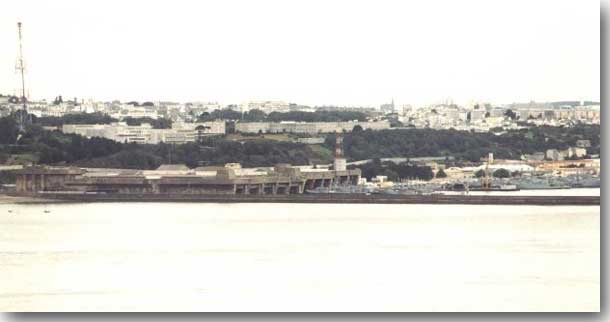
U-Boat Base at Brest
Vice Admiral Karl Donitz, in command of the U-Boat fleet, soon grabbed this opportunity to build almost impregnable bases in five French, Bay of Biscay ports, from North to South these were, Brest, Lorient, St Nazaire, La Rochelle, and Bordeaux. These bases would allow the U-Boats to spend an extra 10 days on patrol. These new bases, sitting on the Atlantic Ocean, would save the Donitz Grey Wolves, a 450 mile journey from Germany via the North Sea, around the top of the British Isles before they could burst out into the Atlantic.
The outcome for all the British Convoys, ships loaded to their plimsol line, with the food and sinews of war, streaming from West to East, would be catastrophic.
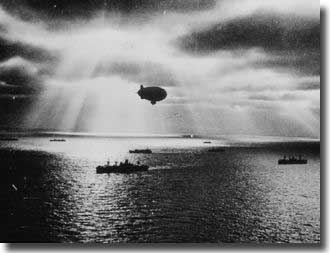
Convoy at Sunrise
Photograph Naval Historical Centre. USA.
It was Admiral Donitz's belief, that his U-Boats could, and would, strangle this life line from North America to Britain, and so his U-Boat arm would win the Battle of the Atlantic, and the war for his Fuhrer. He was so very nearly right.
Churchill was to say " The only thing to really frighten me was the U-Boat war." and with good reason. During the first year of WW2, when only 6 U-Boats were deployed on patrol at any one time, 4 million tons of the Merchant Fleet was lying on the floor of the Atlantic Ocean.

St Nazaire U-Boat pens
Building the U-Boat bunkers at the Bay of Biscay ports of France.A German construction company Organisation Todt ( OT ) created by Fritz Todt, built communication links and defence structures. He died in an air crash in 1942, when Albert Speer, who had been appointed the Reich Architect by Adolph Hitler, took this group under his control as part of the Central Planning Board. OT became responsible for building all the U-Boat bunkers, and pens, along the French Bay of Biscay, it was an immense project, that in quantity of materials needed, stood alongside the massive Hoover Dam Programme in the United States.
Lorient.
The first of these to start construction was the base at Lorient, where Keroman 1 bunker was completed by September in 1941, Keroman 11 was ready in December 1941, and Keroman 111 in January of 1943.

French U-Boat Ports of Brest, Lorient, St Nazaire, La Rochelle and Bordeaux
Keroman 1.
This bunker was 120 metres long by 85 metres wide and 18.5 metres high, the roof protection was 3.5 metres thick. It had 5 dry dock pens K1 to K5, and a slip for lifting a U-Boat clear of the water.
Keroman 11.
Was located immediately behind Keroman 1, 138 metres long by 128 metres wide, and 18.5 metres high. Once again the roof was 3.5 metres thick. It had seven pens, K6 to K 12.
Keroman 111.
The largest of all three of these bunkers, 170 metres long by 135 metres wide, and a height of 20 metres. Here the roof protection was 6.4 metres thick.
The U-Boat accommodation consisted of seven pens, including two repair pens each of which, took two boats, side by side, and another five mooring areas, K13 to K24. It took but one hour to lift a submarine from the water, and transport it to the most distant area. Steel doors 3 feet thick, clanged shut behind each pen to secure a U-Boat.
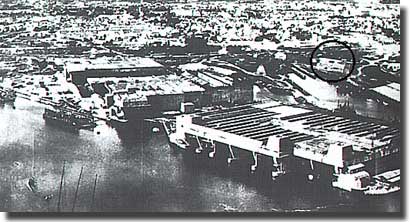
The three Keroman bunkers. At first Keroman III, behind Keroman I and then Keroman II.
In the circle the East Dombunker
Two Dom Bunkers.
At Lorient, prior to the construction of the three Keroman Bunkers, there were two Dom Bunkers, so called because of their Cathedral like shape. These were known as the East and West Dom Bunkers, and were 81 metres long by 16 metres wide and 25 metres high, each of these could shelter one U-Boat.
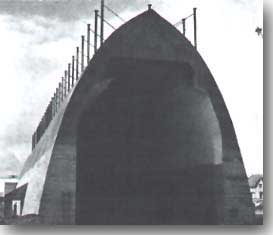
East Dom Bunker at Lorient 1941. Capable of sheltering but 1 U-Boat.
Built prior to the construction of the three Keroman shelters or bunkers
Karl Donitz, Chateau de Ter, and his Headquarter's Bunker.
In the port of Keroman at Lorient, at Kerneval, facing the west bank of the Ter River, the Lion of the U-Boats, Vice Admiral Karl Donitz acquired the Chateau de Ter for his use, it had been built in latter half of the 19th. century. OT built a 10,000 square foot bunker alongside the chateau to house his command HQ. It included a 200 man signals group, from here for 17 months, Donitz ran his U-Boat fleet in the desperate Battle of the Atlantic, almost bringing Britain to her knees.
He only moved his HQ to Paris in May of 1942 at the insistence of Admiral Raeder, after the British Commando raid on St Nazaire on the 28th. of March 1942, as it was feared Donitz may be a target for capture in a future raid.
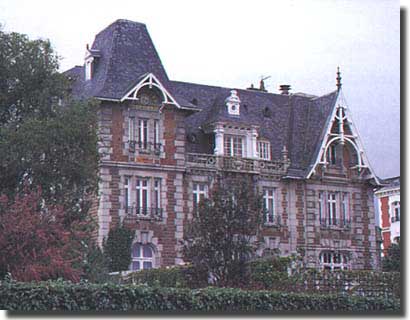
From here Admiral Dönitz led for 17 months the wolfpacks in the Atlantic
Brest.
The most northern of all the five U-Boat bases was at Brest. Here construction started in January of 1941, and the 333 metres long by 192 metres wide and 17 metres high complex with its protective roof about 7 metres thick, was ready to receive its first boats in September of that year. It contained 13 pens A to E, each being able to hold two U-Boats, and those numbered 1 to 8. Both the 1st. and 9th. Flotillas operated out of this complex.

U-106 and U-124 dry docked at Brest
Bombing Attacks.
The Allied airforces attacked the Brest bunkers with little effect until Barnes Wallis had developed his massive 12,000 pound Tallboy bomb. It was not until August of 1944 that any real damage was done to these bunkers at Brest, here is the report of two raids that month.
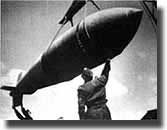
The Tallboy bomb developed to pierce reinforced concrete,
and used against the Bay of Biscay U-boat pens
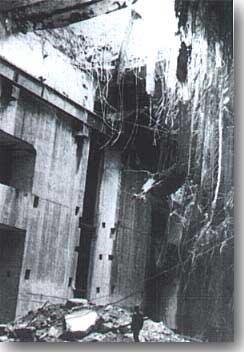
Bomb damage at Brest U-boat base in August 1944
5th August 1944
The first attacks on the pens by 617 squadron & 9 squadron. Previous attacks had failed to inflict any damage to the pens due to it's construction. At least five direct hits were reported using the Tallboy bombs of the five, three penetrated the pens, the break water outside the pens was also damaged. Lost on this attack was JB139 KC-V Type "Lancaster III"
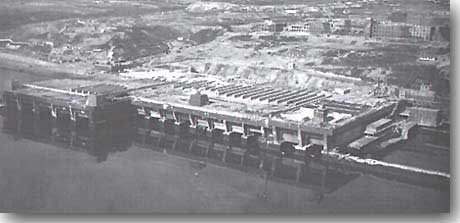
U-Boat pens at Brest
12th August 1944
Saw the second attack of the pens by 617 squadron & 9 squadron, this time no aircraft were lost but four were hit by heavy flak, the result of this attack was more damage to the pens and two tanker ships the Rade and Wat Kross were sunk.

St Nazaire bunkers
St Nazaire.
4000 OT personnel toiled between 1941 and 1942 to build this bunker over 1941/1942, comprising 14 pens to take 20 U-boats. It was huge, 295 metres long by 130 metres wide and 18 metres high, and had the most complete roof structure of all the Bay of Biscay bases. It was made up of seven sections over 25 feet in depth.
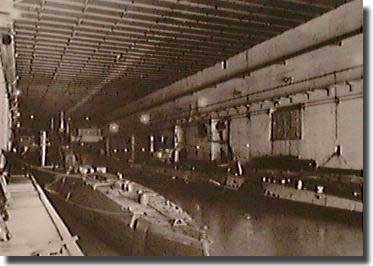
Inside one of the pens at St Nazaire in 1945
U- 203, The first U-Boat, to use these facilities docked on the 30th. of June 1941, but four months after work here had commenced. The base was fully operational by October 1942, and both the 6th.and 7th. U-Boat Flotillas called St Nazaire home.

U-203 the first boat to use the new bunker at St Nazaire, arriving on the 30th. of June 1941
Bombing attacks.
By July of 1944, 2,000 tons of bombs had been unloaded on the port, and most of the town was destroyed, however the bunkers were relatively immune to these bombing attacks, the intricate roof structure holding firm.

La Rochelle U-Boat pens
La Pallice/La Rochelle.
This base was also used by Italian Submarines as an alternative to their one at Bordeaux. The first two, of a final ten pens was built by October 1941, the size being 195 metres long by 165 metres wide and 19 metres high. The German 3rd. Flotilla made its base here, and U-82 was the first arrival on the 9th. of November 1941.
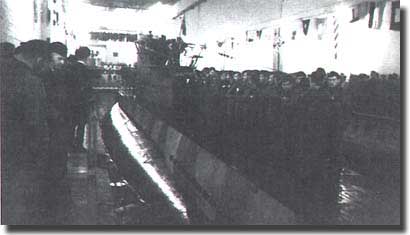
U-82 the first submarine in the new facility at La Pallice/La Rochelle on the 9th. of November 1941
Bordeaux.
The most southern of all the Bay of Biscay bases at Bordeaux, is not actually located on the Atlantic coast, but is situated some 60 miles inland on the Gironde River, Donitz decided he wanted a Bunker facility built here, and that work commenced in September 1941.
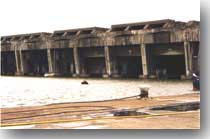
Bordeaux Bunker, 3 wet pens and 8 dry
Eventually an 11 pen structure, 7 of which had dry dock facilities, was available in a complex, 245 metres long by 162 metres wide and with a height of 19 metres. The roof had a varying thickness from 5.6 metres to about 3.6 metres over the rear servicing area.
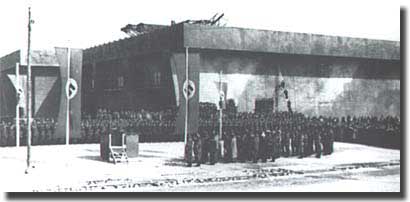
Opening the Bordeaux Bunker early in 1943
First Boat to arrive.
U-178 arriving on the 17th. of June 1943 was the first German boat to dock here. Some 25 Italian Submarines were to be based here, and attempts were made to effect cooperation with the German Wolf Packs, but in general these failed, the losses of the Italian boats were on the whole less than those suffered by their German counterparts. I guess the inference here is perhaps the Italian Submarines did not press home their attacks as did, their German Allies.
Bordeaux home to supply Boats.
The supply boats, milche cow Type XIV submarines, the mine layers, and torpedo transports, all made Bordeaux their Home Base.
Private Use.
Today this bunker is in private hands, but it is possible to gain permission to visit the facility which was obviously built, as were its Northern sisters, to last for an eternity.
Conclusion.
These 5 bases gobbled up 14 Million Cubic feet of concrete, and a Million tons of steel. All well worth the effort from the German viewpoint, serving U-Boat Command well. I believe that they aided Vice Admiral Donitz in extending his fight against the Allied Convoys, in the Battle of the Atlantic, in which he might so easily have been the victor.


















